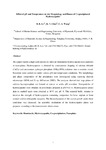Effect of pH and temperature on the morphology and phases of co-precipitated hydroxyapatite
| dc.contributor.author | Le, HR | |
| dc.contributor.author | Chen, KY | |
| dc.contributor.author | Wang, CA | |
| dc.date.accessioned | 2015-02-23T11:45:56Z | |
| dc.date.available | 2015-02-23T11:45:56Z | |
| dc.date.issued | 2012-03 | |
| dc.identifier.issn | 0928-0707 | |
| dc.identifier.issn | 1573-4846 | |
| dc.identifier.uri | http://hdl.handle.net/10026.1/3260 | |
| dc.description.abstract |
This paper reports a high-yield process to fabricate biomimetic hydroxyapatite nano-particles or nano-plates. Hydroxyapatite is obtained by simultaneous dripping of calcium chloride and ammonium hydrogen phosphate solutions into a reaction vessel. Reactions were carried out under various pH and temperature conditions. The morphology and phase composition of the precipitates were investigated using scanning electron microscope and X-ray diffraction. The analyses showed that large plates of calcium hydrophosphate are formed at neutral or acidic pH condition. Nanoparticles of hydroxyapatite were obtained in precipitates prepared at pH 9–11. Hydroxyapatite plates akin to seashell nacre were obtained at 40 °C and pH 9. This material holds promise to improve the strength of hydroxyapatite containing composites for bone implant or bone cement used in orthopaedic surgeries. The thermodynamics of the crystal growth under these conditions was discussed. An assembly mechanism of the hydroxyapatite plates was proposed according to the nanostructure observations. | |
| dc.format.extent | 592-599 | |
| dc.language | en | |
| dc.language.iso | en | |
| dc.publisher | Springer Science and Business Media LLC | |
| dc.subject | Biomimetic | |
| dc.subject | Hydroxyapatite | |
| dc.subject | Co-precipitation | |
| dc.subject | Nanoplate | |
| dc.title | Effect of pH and temperature on the morphology and phases of co-precipitated hydroxyapatite | |
| dc.type | journal-article | |
| plymouth.author-url | https://www.webofscience.com/api/gateway?GWVersion=2&SrcApp=PARTNER_APP&SrcAuth=LinksAMR&KeyUT=WOS:000301544000018&DestLinkType=FullRecord&DestApp=ALL_WOS&UsrCustomerID=11bb513d99f797142bcfeffcc58ea008 | |
| plymouth.issue | 3 | |
| plymouth.volume | 61 | |
| plymouth.publication-status | Published | |
| plymouth.journal | Journal of Sol-Gel Science and Technology | |
| dc.identifier.doi | 10.1007/s10971-011-2665-7 | |
| plymouth.organisational-group | /Plymouth | |
| plymouth.organisational-group | /Plymouth/Research Groups | |
| plymouth.organisational-group | /Plymouth/Research Groups/Marine Institute | |
| dcterms.dateAccepted | 2011-12-20 | |
| dc.identifier.eissn | 1573-4846 | |
| dc.rights.embargoperiod | Not known | |
| rioxxterms.versionofrecord | 10.1007/s10971-011-2665-7 | |
| rioxxterms.licenseref.uri | http://www.rioxx.net/licenses/all-rights-reserved | |
| rioxxterms.type | Journal Article/Review |


